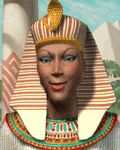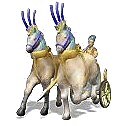The Egyptians |
|||||||||||||||||||||||
| Profile | |||||||||||||||||||||||
|
|||||||||||||||||||||||
|
Egyptian Cities
Great Leaders
|
Background
Few civilizations have left such an indelible mark on history as that of ancient Egypt. Though the first settlers of the Nile valley are thought to have arrived as early as 7000 BC, it wasn’t until the legendary king Menes unified Upper and Lower Egypt that the region began to develop a cohesive sense of culture and identity. This First Dynasty (2925-2775 BC), with its capital at Memphis, was followed by 26 more over the next 2700 years. Writing was the major instrument in the centralization and self-preservation of Egypt. The two basic forms of writing, hieroglyphs and the cursive form known as hieratic (used on papyrus), were invented at much the same time in late pre-dynastic Egypt (about 3000 BC). Writing was used chiefly for administration and until about 2650 BC no continuous texts were recorded; the only literary texts written down before the early Middle Kingdom (1950 BC) seem to have been lists of religious practices and medical treatises. Another strength was the Egyptian religion, which was one of the most enduring of the ancient world, through which Egypt became a highly stratified, highly efficient society. Egypt’s economic strength allowed for the support of a priestly class, who were tasked with the spiritual well being of the people yet able to devote their time to the study of religion, astronomy, philosophy and mathematics. The priesthood also served the functions of a state bureaucracy, carrying out the edicts of the Pharaoh and managing his financial and diplomatic affairs. The great organizational and economic power of Egypt allowed the rulers to accomplish unmatched works of construction. The Great Pyramids of Giza, completed in the Fourth Dynasty (2575-2465 BC), still stand as one of mankind’s most impressive feats of engineering and logistics. Previous to 1700 BC, no outsiders had ever held dominion over Egypt. That changed when the Hyksos, a Semitic people, overran Lower Egypt. Thereafter, Egypt’s borders were defended by capable Libyan warriors and the elite often rode into battle in War Chariots, which were able to use speed to outflank opponents and break up organized formations of troops. Egypt’s greatest military strength, however, lay in the employment of mercenaries from Macedonia, Greece, Nubia and many other neighboring peoples – Egyptian gold was always their most valuable military asset. However, this was not enough to guarantee the isolation of the richest land in the Mediterranean world. Egypt fell to the Assyrians, and then to the Persians yet even during the plunder of Xerxes’ governors, Egyptian culture and religion survived. Alexander the Great liberated the Egyptians from Persian rule in 332 BC and established the city of Alexandria, which was to become the new capital of Hellenic Egypt under the rule of the Macedonian Ptolemaic dynasty (332-30 BC), the last Egyptian kingdom. The kingdom was one of several that emerged in the aftermath of Alexander’s death and the struggles of his successors. It was the wealthiest, however, and for much of the next 300 years, the most powerful politically and militarily. The able Ptolemies ruled in an unbroken line until the death of Cleopatra VII in 30 BC. Cleopatra’s infamous liaisons with Julius Caesar and Mark Antony proved the eventual downfall of independent Egypt. Her ambition rivaled theirs, and sadly it served her no better. Her suicide marked the end of Pharaohic rule and the beginning of Egypt’s centuries as a Roman and Byzantine province. Although swept by the Islamic tide in 642 AD, Egypt was to remain under foreign occupation – Arabic, Ottoman, French and British – until after World War I, when she finally gained her independence from a British administration weary of overseas conflict. From 1922 through 1952, Egypt appeared to be one of the world’s most successful constitutional monarchies. But it was ripe for revolution; the military coup of July 1952 led by Gamal Nasser, ironically, finally made Egypt an island of stability in a turbulent Middle East. Unique Unit: the War Chariot The War Chariot is a more powerful version of the standard chariot. It has twice the attack strength of a normal chariot, and the same movement rate. This allows the War Chariot to quickly close on an enemy and attack, with much better odds of inflicting damage.
|
||||||||||||||||||||||

 The Egyptians are religious and industrious. They start the game with Masonry and Ceremonial Burial and build war chariots instead of normal chariots.
The Egyptians are religious and industrious. They start the game with Masonry and Ceremonial Burial and build war chariots instead of normal chariots.  When the Hyksos were booted out of Egypt by Ahmose in the years between 1580 and 1522 BC, they left behind a lot of things: pocket change, household items, and a few nifty little toys they called "chariots". Ahmose made the most of this opportunity. While we don’t know what he did with the pocket change, we do know that he made the chariot the centerpiece of his new and improved Egyptian army, which dominated the Middle Eastern theatre of war for hundreds of years, until they were supplanted by horse-mounted soldiers, which were cheaper and more durable.
When the Hyksos were booted out of Egypt by Ahmose in the years between 1580 and 1522 BC, they left behind a lot of things: pocket change, household items, and a few nifty little toys they called "chariots". Ahmose made the most of this opportunity. While we don’t know what he did with the pocket change, we do know that he made the chariot the centerpiece of his new and improved Egyptian army, which dominated the Middle Eastern theatre of war for hundreds of years, until they were supplanted by horse-mounted soldiers, which were cheaper and more durable.